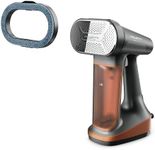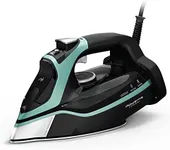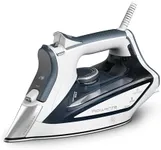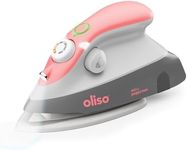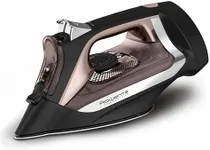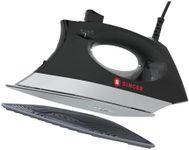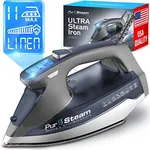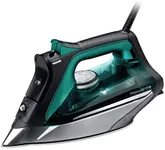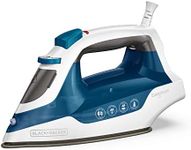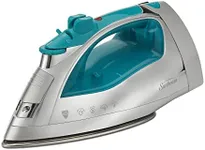Buying Guide for the Best Steam Iron For Sewing
Choosing the right steam iron for sewing can make a big difference in the quality and ease of your sewing projects. A good steam iron helps you press seams, remove wrinkles, and set fabric shapes, which is essential for professional-looking results. When shopping for a steam iron, it's important to consider features that match your sewing habits and the types of fabrics you work with most often. Understanding the key specifications will help you find an iron that is comfortable to use, effective on different materials, and reliable for long sewing sessions.Steam OutputSteam output refers to how much steam the iron produces, usually measured in grams per minute. This is important because more steam helps to relax fabric fibers and remove wrinkles more easily, which is especially useful for thicker or stubborn fabrics. Low steam output is suitable for delicate fabrics and light pressing, while medium output works well for everyday fabrics like cotton. High steam output is best for heavy fabrics or when you need to press multiple layers. Choose a steam output that matches the types of fabrics you sew most often.
Soleplate MaterialThe soleplate is the flat, heated surface that touches your fabric. Common materials include stainless steel, ceramic, and non-stick coatings. Stainless steel soleplates glide smoothly and are durable, making them good for frequent use. Ceramic soleplates distribute heat evenly and are less likely to stick to fabrics, which is helpful for delicate materials. Non-stick soleplates are easy to clean and prevent fabric from sticking, but may wear out faster. Pick a soleplate material that suits your sewing frequency and the types of fabrics you handle.
Temperature ControlTemperature control lets you adjust the heat of the iron to match different fabric types. This is crucial because some fabrics, like silk or synthetics, can be damaged by high heat, while others, like cotton or linen, need higher temperatures to press properly. Basic irons have simple dial controls, while advanced models offer digital or precise settings. If you work with a wide range of fabrics, look for an iron with easy-to-use and accurate temperature controls.
Water Tank CapacityThe water tank holds the water that is turned into steam. A larger tank means you can iron for longer without refilling, which is convenient for big sewing projects. Small tanks make the iron lighter and easier to handle, but require more frequent refills. If you often sew for long periods or work on large projects, a bigger water tank can save time and effort. For quick or occasional pressing, a smaller tank may be sufficient.
Weight and ErgonomicsThe weight and design of the iron affect how comfortable it is to use, especially during long sewing sessions. Heavier irons press fabric more effectively with less effort, but can be tiring to hold. Lighter irons are easier to maneuver, which is helpful for detailed work or when pressing small pieces. Ergonomic handles and balanced designs reduce hand strain. Consider your own strength and how long you typically iron when choosing the right weight and shape.
Precision TipA precision tip is a pointed or narrow end on the iron's soleplate, designed to help you reach tight spots like seams, pleats, and corners. This feature is especially useful for sewing, as it allows you to press detailed areas without affecting the rest of the fabric. If you often work on garments or projects with intricate details, look for an iron with a well-designed precision tip.
Anti-Drip and Anti-Scale FeaturesAnti-drip prevents water from leaking out of the iron at low temperatures, which can stain or wet your fabric. Anti-scale features help prevent mineral buildup inside the iron, which can affect steam performance and lifespan. These features are important if you use the iron frequently or live in an area with hard water. If you want a low-maintenance iron that keeps your fabrics clean, consider these features.
